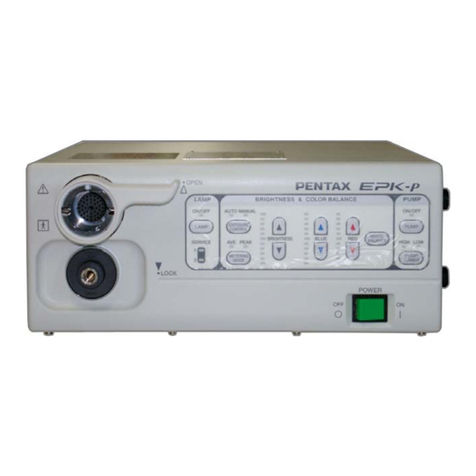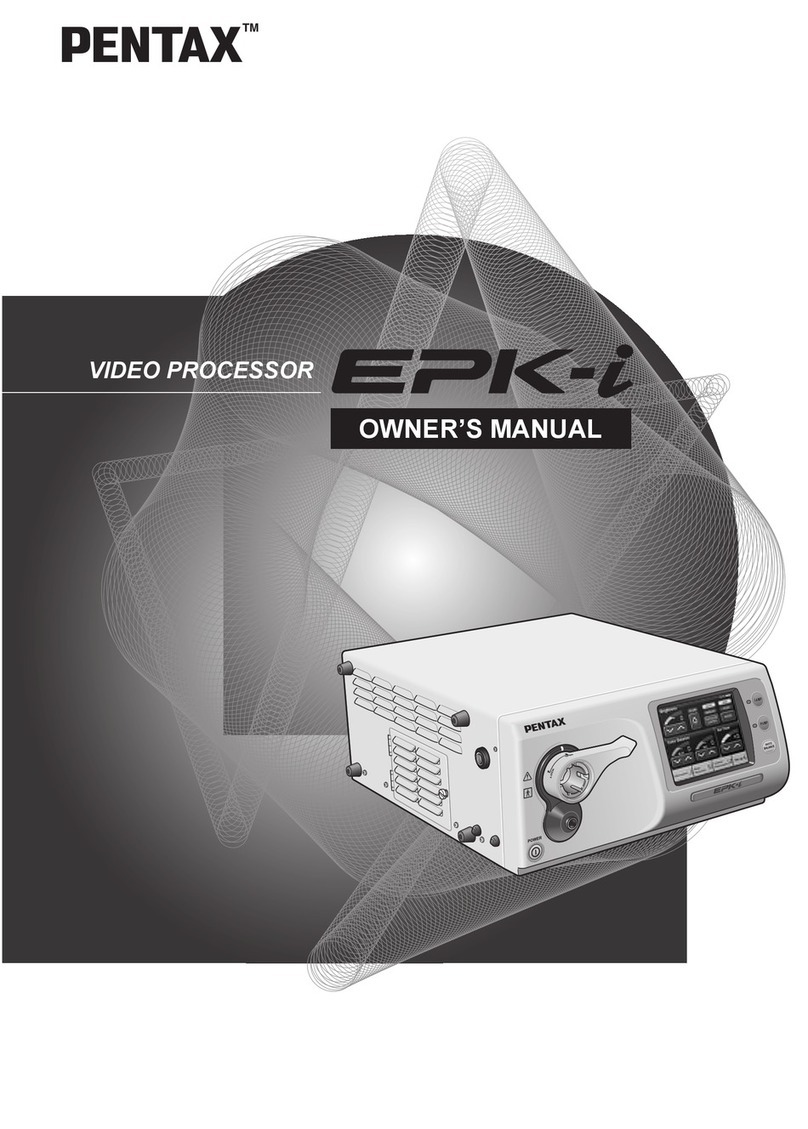
- 2 -
2. General explanations
The PENTAX
E
EP
PK
K-
-p
p
has a halogen lamp as a right bulb that costs relatively less. However it is
compatible with not merely the ordinary 70K/80K series scopes but also 90K series scopes, which is a
high-cost performance video processor. No unnecessary things are equipped. All minimally-necessary
functions are installed. While following these features of Type-A, B, some points were improved in terms
of its profitability, productivity and functionality.
1) Light source>A halogen lamp 150W is introduced as a light source. Its life time is 50 hours. Two
halogen lamps are mounted on the lamp rotary disk inside. The two lamps can be selected with the
lamp selector. Upon operation the lamp selector the lamp rotation disk driven by a DC motor
revolves so the selected lamp goes to the light axis. In the case that the lamp wore out of light, the
warning message “Please replace the lamp 1 (or lamp 2)” appears on the monitor and SERVICE
indicator lights in red. The lamp is replaceable from the lamp house lid located on the left side of the
unit. Comparing with Type-A, B, the lamp rotation disk is redesigned in order to withdraw the lamp
outside when the lamp is replaced. It contributes to easier lamp replacement. The construction of
the lamp rotation disk was modified so that the rotation disk adjustment is no longer necessary.
2) Contrast> By changing the linearity of the Y luminance signal, contrast of the image can be
changed in the EPK-p. Contrast changes cyclically by pressing “F9” key “Normal” > “High” > “Low”.
3) Starting lamp> The lamp can light by not merely pressing “LAMP” button but also setting the lamp
start mode. In the case that the item “Lamp” on “Setup” tab of “Configuration Screen” actuated by
pressing “F10” key is set with “Start”, the lamp lights when the main power is turned ON. With “Lock
lever”, it starts when the scope lock lever is completely locked. With “OFF”, “LAMP” button must be
pressed to turn on the lamp.
4) Mirroring, Rotating images> The image can be mirrored or rotated and displayed on the monitor.
In the case that the item “Image Direction” on “Display” tab of “Configuration Screen” actuated by
pressing “F10” key is set with “MIRROR”, the image is displayed in mirrored status. With “ROTATE”,
it is displayed rotated. With “Normal”, this is default.
In addition to these former futures,
5) Scope image> Although the subjective analysis, it is generally evaluated that the observing image
is improved with richer color.
6) DC power supply unit> To simplify the structure, DC power supply units previously independently
available (for the patient circuit, secondary circuit and lamps) were combined into one unit.
Accordingly the isolation transformer was removed.
7) Rear panel> No paint is applied to the rear panel. It shines in silver, but is coated with nickel. Thus
it is not likely to rust.
3. Functions (Refer to Fig-1 Function diagram)
1) Process Board (E700)
Process board (E700) consists of the seven parts in terms of its function. These are (1)Preprocessing
part, (2)Processing part, (3)CPU part, (4)Encoding part, (5)Peripheral control part, (6)DC power supply,
and (7)I/O part.
(1) Preprocessing part >
•This part has photo couplers to isolate the patient circuit and the secondary circuit.
•Y/C signal from the K series scope is converted into 10 bit YCrCb signal.
•The scope data is transferred to CPU part through the photo couplers by the serial transfer and
vice versa.
(2) Process part >
•FPGA and video memory are available. 10bit YCrCb signal is converted into 10 bit R, G, B signal
and transferred to Encoder part for analog Y/C and RGB signal.
•Fixed characters like “AGE” stored in the CPU memory and entered characters by the keyboard are
transferred from the CPU part and merged with the image in the FPGA.
•At iris auto mode, luminance signal extracted from 10 bit YCrCb signal and the reference voltage
from the CPU are compared in the FPGA and FPGA calculates and sends the iris drive voltage to
Peripheral control part to control the iris in auto mode. At iris manual mode, the reference voltage
from the CPU is converted into the iris drive voltage and sends it to also Peripheral control part to
control the iris in manual mode.


































